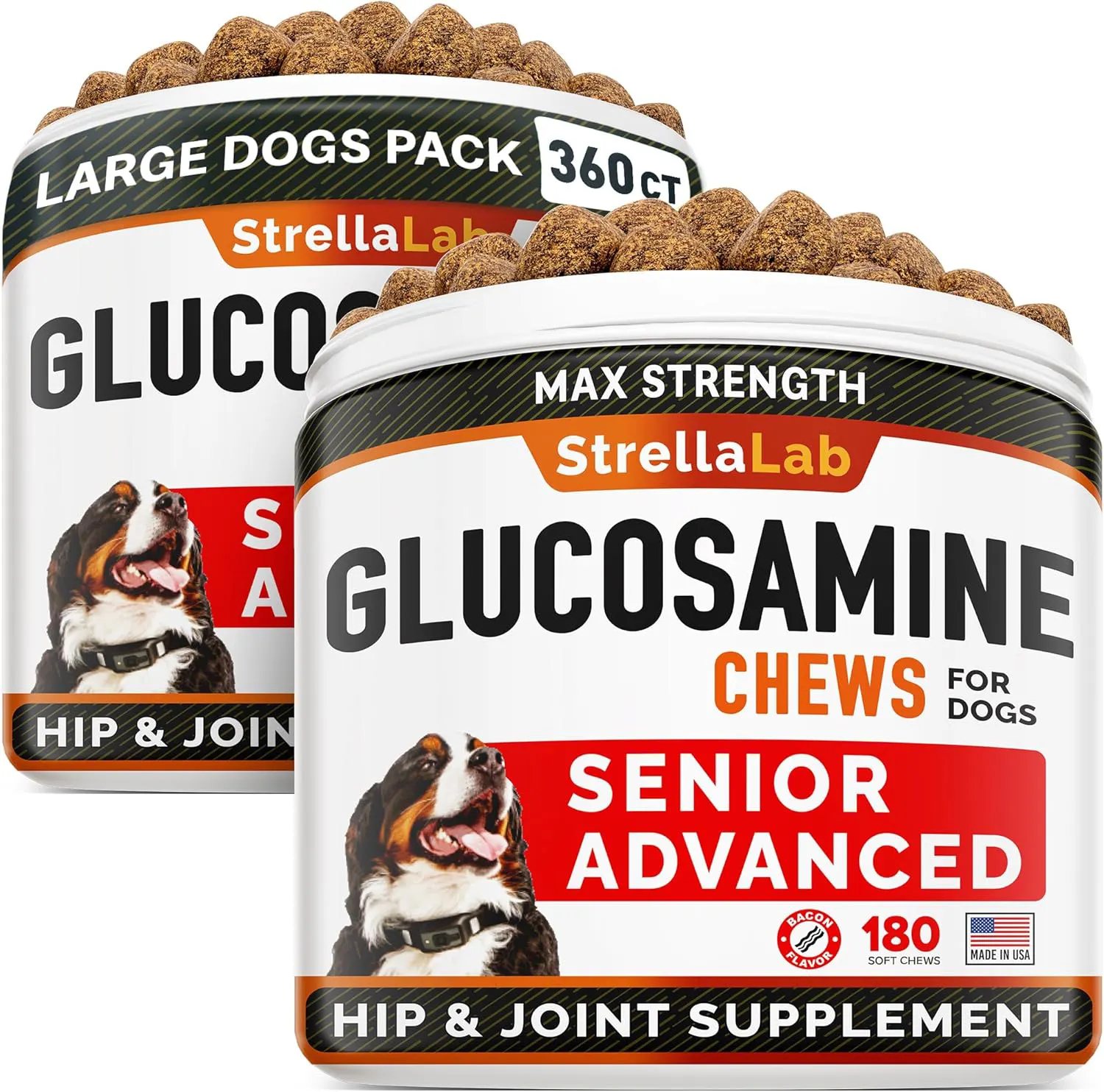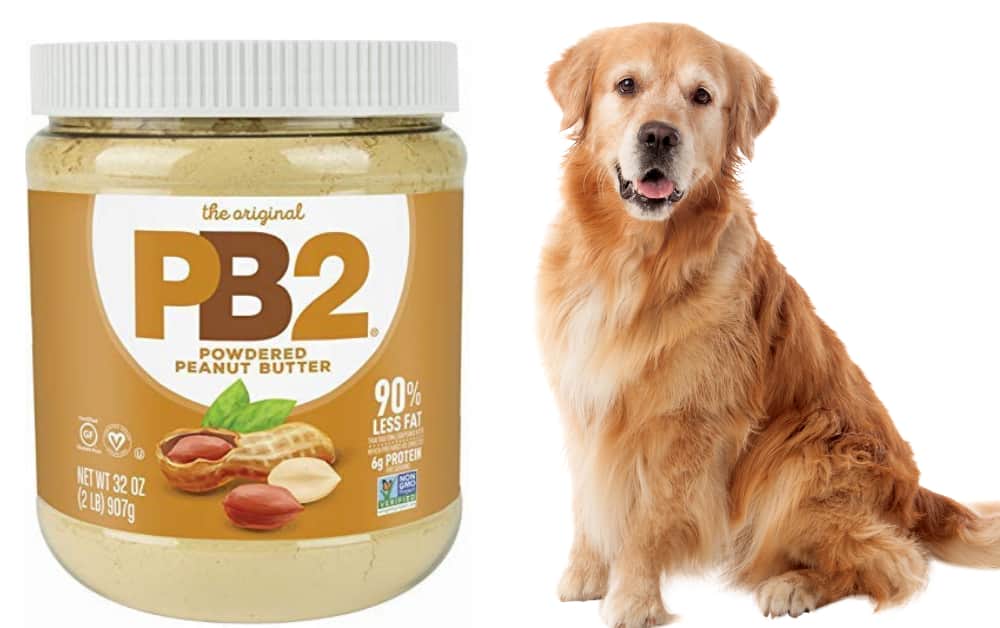Glucosamine is a natural compound found in your dog’s body, primarily in cartilage – the tough, spongy tissue that cushions joints. It plays a critical role in building and maintaining healthy joint function by supporting the production of glycosaminoglycans and proteoglycans. These substances help form and repair cartilage, which can wear down over time, especially in older dogs or those with high activity levels.
Glucosamine For Dogs: As dogs age, their bodies may produce less glucosamine, leading to joint stiffness, pain, and reduced mobility. That’s where supplementation comes in. Commercial glucosamine for dogs is usually derived from shellfish shells or made synthetically in labs.
It’s widely available in various forms, including tablets, powders, chews, and liquids, making it easy to incorporate into your pet’s daily routine.
Glucosamine is often combined with other joint-supportive ingredients like chondroitin sulfate and MSM (methylsulfonylmethane), which work synergistically to enhance effectiveness. These supplements are especially popular among pet owners looking to help their dogs age comfortably or recover from joint injuries.
Glucosamine Dosage For Dogs
The ideal glucosamine dosage for dogs is 10 mg per pound (22 mg per kg) of body weight, given twice daily. For example, a 50 lb (22.7 kg) dog would typically need 500 mg of glucosamine twice a day.
The general glucosamine dosage guidelines for dogs are:
- Less than 25lbs: 250-500 mg
- 25lbs to 50lbs: 500 mg
- 50lbs to 90lbs: 1,000 mg
- 90lbs+: 1,500 mg
Always consult your veterinarian before starting any joint supplements to ensure proper dosage and safety based on your dog’s specific health needs.
Glucosamine Dosage Chart for Dogs by Weight
| Dog’s Weight | Weight (kg) | Glucosamine per Dose | Total Daily Dosage (Divide in 2 Doses/Day) |
|---|---|---|---|
| 5 lbs | 2.3 kg | 50 mg | 100 mg |
| 10 lbs | 4.5 kg | 100 mg | 200 mg |
| 20 lbs | 9.1 kg | 200 mg | 400 mg |
| 30 lbs | 13.6 kg | 300 mg | 600 mg |
| 40 lbs | 18.1 kg | 400 mg | 800 mg |
| 50 lbs | 22.7 kg | 500 mg | 1000 mg |
| 60 lbs | 27.2 kg | 600 mg | 1200 mg |
| 70 lbs | 31.8 kg | 700 mg | 1400 mg |
| 80 lbs | 36.3 kg | 800 mg | 1600 mg |
| 90 lbs | 40.8 kg | 900 mg | 1800 mg |
| 100 lbs | 45.4 kg | 1000 mg | 2000 mg |
Why Dogs Need Glucosamine
Glucosamine isn’t just for aging dogs. It’s a powerful ally for pups of all sizes and breeds who might be dealing with joint wear and tear due to genetics, injury, overuse, or lifestyle
Dogs that are particularly active—like agility dogs, hunting breeds, or those who love a good game of fetch—put a lot of pressure on their joints. Over time, this repeated stress can cause cartilage breakdown, leading to pain and inflammation. Preventive supplementation can keep those joints in better shape longer.
Even smaller breeds aren’t exempt. While they might not have the same intense physical demands as larger dogs, many small breeds are prone to joint issues like patellar luxation. A daily glucosamine supplement can reduce the likelihood of serious mobility problems later in life.
Benefits of Glucosamine for Dogs
Joint Support and Mobility
One of the biggest perks of glucosamine for dogs is how well it supports joint health and overall mobility. Think of glucosamine like a cushion restorer. As cartilage wears down, your dog’s bones begin to rub together more often, which causes pain and inflammation. Glucosamine helps rebuild that cushion, allowing your pup to move more freely and with less discomfort.
Dogs who take glucosamine regularly often show noticeable improvements in their ability to walk, climb stairs, jump into the car, or play in the yard. It’s especially helpful for dogs with osteoarthritis, a condition that affects nearly one in five adult dogs. Research shows that dogs on glucosamine experience reduced stiffness and improved weight-bearing capacity on affected limbs.
Another benefit? Better flexibility. By promoting healthier cartilage and reducing inflammation, glucosamine helps your dog stay limber and active. This can be a game-changer for senior pets who’ve started slowing down or avoiding their favorite activities due to joint pain.
Pain Relief and Inflammation Reduction
Glucosamine is not a painkiller in the traditional sense, but its anti-inflammatory properties can significantly reduce discomfort over time. When cartilage deteriorates, joints become inflamed, leading to swelling, tenderness, and pain. Glucosamine works at the root of the problem by helping the body repair cartilage and reduce that inflammation naturally.
It’s often used as a complementary therapy alongside medications like NSAIDs (non-steroidal anti-inflammatory drugs). While NSAIDs are effective, they can come with side effects when used long-term. Glucosamine offers a gentler, more natural alternative that’s safe for prolonged use.
What’s more, dogs that experience chronic pain from conditions like hip dysplasia, arthritis, or previous injuries may benefit immensely from a consistent glucosamine regimen. Over several weeks, many owners notice their dogs become more comfortable and less dependent on stronger pharmaceuticals.
Preventive Care for Aging Dogs
Starting glucosamine early can act as preventive maintenance for your dog’s joints. Just like you wouldn’t wait for your car’s engine to seize before getting an oil change, don’t wait for your dog’s joints to break down before giving them support.
As dogs grow older, the natural production of joint lubricants like synovial fluid begins to slow. This causes stiffness, cracking sounds in the joints, and visible pain during movement. Glucosamine helps to restore some of that lost lubrication, preserving cartilage and joint integrity before serious problems set in.
Veterinarians often recommend introducing glucosamine supplements to dogs as early as 5–7 years old, especially for breeds with known predispositions to joint issues like German Shepherds, Labradors, and Great Danes. It’s an affordable and easy way to enhance your pet’s quality of life well into their golden years.
Signs Your Dog Might Need Glucosamine
Early Signs of Joint Issues
Your dog can’t tell you their joints hurt—but they can show it. Subtle changes in behavior are often the first clue that something’s wrong. Here are early signs to watch for:
- Hesitation when jumping on or off furniture
- Limping or stiffness, especially after naps
- Decreased enthusiasm during walks or play
- Favoring one leg or joint
- Reluctance to climb stairs
- Behavioral changes like irritability or withdrawal
These symptoms often worsen gradually, making them easy to overlook. That’s why it’s so important to observe your dog closely, especially if they’re agTerms & Conditionsing or part of a high-risk breed.
Even if your pup hasn’t been officially diagnosed with arthritis, early intervention with glucosamine can help maintain joint health and possibly delay more severe conditions.
Breed-Specific Risks Issues
Certain breeds are genetically more prone to joint problems, making them prime candidates for early glucosamine supplementation. Here’s a list of some common high-risk breeds:
- Labrador Retrievers: Prone to hip and elbow dysplasia
- German Shepherds: Susceptible to degenerative joint diseases
- Dachshunds: Vulnerable to spinal disc issues
- Boxers: Often experience knee and hip problems
- Great Danes & Mastiffs: Joint stress from sheer body mass
If your dog is part of one of these breeds, it’s a smart move to begin joint supplements early—even as young as 1–2 years for giant breeds. Prevention now can save pain and medical expenses later.
Post-Injury or Post-Surgery Recovery Issues
Dogs recovering from orthopedic injuries or surgeries, such as ACL tears or hip replacements, greatly benefit from glucosamine. These supplements help speed up cartilage regeneration and reduce inflammation, creating a more comfortable recovery process.
Vets often recommend a higher initial dose during recovery, tapering down as your dog heals. When paired with physical therapy and a balanced diet, glucosamine can be the difference between slow healing and a smooth comeback.
If your pup is on the mend, make sure to follow your vet’s instructions for dosage and check-in regularly to monitor progress.
Glucosamine Side Effects For Dogs
Glucosamine is generally safe for dogs, but like any supplement, it’s not completely free from side effects. The most common reactions are mild and usually go away on their own. These include:
These usually happen when starting glucosamine for the first time or when the dose is too high. If your dog experiences mild side effects, try reducing the dose temporarily and slowly increasing it again after a few days.
Rare but Serious Reactions
Though uncommon, some dogs may have allergic reactions—especially if the glucosamine is derived from shellfish. Symptoms of a more serious issue might include:
If you notice any of these, stop giving the supplement immediately and contact your veterinarian. Always check the ingredient list carefully if your dog has known food allergies.
Some supplements may also include added ingredients like xylitol, which is toxic to dogs, so double-check the label before buying.
When to Stop Giving Glucosamine
There are a few cases where it might be best to pause or stop glucosamine altogether:
- Your dog develops ongoing GI issues
- There’s no improvement after 8–10 weeks
- Your vet advises switching to a different treatment
If your dog’s condition worsens, don’t assume the supplement isn’t working—it might be that they need a higher dose or a different formulation. Regular vet checkups are crucial to make sure the treatment plan stays on track.
You May Also Like To Read:
FAQs
Can I give my dog human glucosamine supplements?
Technically, yes—but it’s not recommended. Human supplements may contain additives or doses inappropriate for dogs, and some contain xylitol, which is toxic. Stick with dog-specific formulations to be safe.
How long does it take for glucosamine to work in dogs?
You’ll usually see results in 4 to 8 weeks. Some dogs respond faster, while others may take longer, especially if joint damage is severe.
Is glucosamine safe for puppies?
Most puppies don’t need glucosamine unless prescribed by a vet for a genetic condition or early signs of joint issues. It’s generally safe, but always consult your vet before starting.
Can I stop giving glucosamine once my dog feels better?
Not advised. Joint damage is usually ongoing, and stopping supplements may cause symptoms to return. Think of it as long-term maintenance, not a temporary fix.
What if I accidentally give my dog too much glucosamine?
Mild overdoses may cause stomach upset, but it’s rarely life-threatening. If you suspect a large overdose or see serious symptoms, call your vet or a pet poison hotline immediately.
Final Thoughts
Glucosamine isn’t just another pet supplement—it’s a powerful ally in the fight against joint pain and mobility loss. Whether your dog is a playful pup or a wise senior, adding glucosamine to their routine can significantly improve their quality of life. From reducing stiffness and boosting mobility to preventing long-term joint damage, it’s one of the best tools pet parents have at their disposal.
The key is getting the dosage right, staying consistent, and pairing it with good vet care and a healthy lifestyle. And remember, not all supplements are created equal—quality matters. Choose a vet-approved brand, keep track of your dog’s progress, and don’t be afraid to ask your vet for guidance.
Your furry friend might not be able to say “thank you,” but their wagging tail, energetic bounce, and happy demeanor will say it all.












![Can Dogs Eat Blood? 7 Side Effects [Expert Opinion]](https://petskor.com/wp-content/uploads/2022/04/Webp.net-resizeimage-12.jpg)
